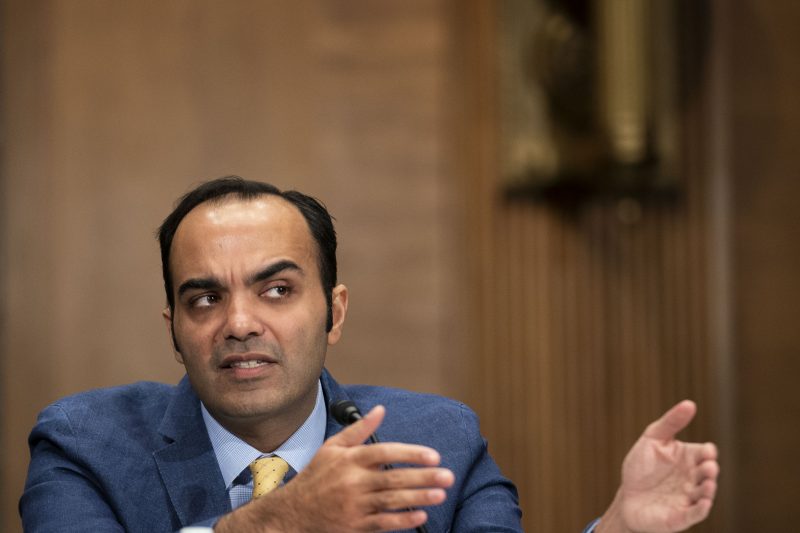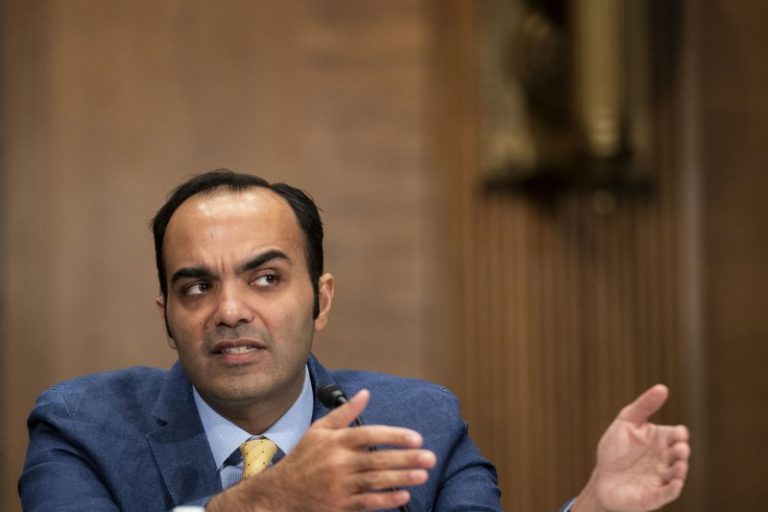
“By our estimates, 75 percent of late fees —$9 billion — have no purpose beyond padding the credit card companies’ profits.”
— Rohit Chopra, director of the Consumer Financial Protection Bureau, remarks during a news briefing, Feb. 1
“Today’s rule proposes to cut those fees from $31 on average to $8 — to $8. That change is expected to save tens of millions of dollars for Americans, roughly $9 billion a year in total savings.”
— President Biden, remarks during White House competitiveness council meeting, Feb. 1
Just days before the annual State of the Union address, the Consumer Financial Protection Bureau (CFPB) proposed a regulation that would effectively cap late fees for most credit cards at $8. The announcement teed up a mention of the proposal in Biden’s speech on Feb. 7. “Look, junk fees may not matter to the very wealthy, but they matter to most other folks in homes like the one I grew up in, like many of you did. They add up to hundreds of dollars a month,” Biden told Congress. “I know how unfair it feels when a company overcharges you and gets away with it. Not anymore.”
The CFPB director said that about 75 percent of overall late fees exist only to pad the profits of banks and credit card issuers. With late fees totaling an estimated $12 billion in 2020, the administration says that reducing fees to $8 would result in $9 billion of annual savings to Americans.
There has been surprisingly little attention to how the CFPB calculated the $9 billion number, which now is part of the president’s talking points — the White House tweeted about the proposed rule on Thursday, saying that “credit card late fees can add up quickly for hardworking families.” But within the banking industry, the calculation remains highly controversial. Banking industry officials maintain that the CFPB conducted a slapdash analysis with data not designed for this purpose, brushing aside or ignoring contrary information. The CFPB says issuers of credit cards missed opportunities to reveal their costs.
“The CFPB’s proposed rule seeks to close a regulatory loophole that has allowed credit card companies to charge Americans excessive late fees for over a decade,” said spokesman Samuel Gilford in a lengthy statement to The Fact Checker. “The proposal is based on an analysis of data that was not available” when regulations on card fees were first implemented more than a decade ago.
One key point: The proposal changes what is known as the “safe harbor” for a late fee. Under a 2010 regulation, issuers can charge $30 for the first late payment and $41 for each subsequent violation without having to explain to regulators why these fees, which are adjusted for inflation, are “reasonable and proportional.” The administration wants to change that number to $8, with no inflation adjustment. That means that issuers of credit cards could charge more — and the CFPB believes at least four of the largest players would do so — but they would have to get approval and provide extensive documentation to make their case.
We’ve dug through the agency’s proposed rule, examined numerous comments that have been submitted and discussed the issue with officials at the CFPB and in the banking industry. Here’s what we learned.
First, as a matter of economics, the cost of credit card fees is spread through the system and people may not realize they are subsidizing costs for others. For instance, merchants who accept a credit card must pay a fee, such as 3 percent, to the credit card issuer. So merchants will raise the retail price of goods to cover the cost of accepting a credit card. The increase may not be as much as 3 percent, but in effect people who use cash and debit cards subsidize people with credit cards.
Similarly, wealthy credit card holders who pay their bills on time and earn reward points are subsidized by cardholders who do not spend enough to earn many points and who pay high rates of interest because they carry balances over time. “Credit card rewards transfer income from less to more educated, from poorer to richer, and from high-to low minority areas, thereby widening existing spatial disparities,” said a working paper published this year by the Federal Reserve. The paper estimated the annual transfer exceeded $15 billion.
So the notion is misplaced that a cut in card late fees would mean that all of the estimated reduction — $9 billion — would go straight into the pockets of Americans. Even if the regulation is adopted, banks probably will find a way to make up lost revenue by redistributing the money earned from late payment fees to other cardholders, including people who never miss a payment. The CFPB acknowledges this fact deep in its filing.
“Since the proposal would reduce issuers’ revenue from late fees, issuers may respond by adjusting interest rates or other card terms to offset the lost income. Issuer responses will affect both the sum of consumer gains and their distribution across market segments and populations,” the proposed rule says. “Total consumer gains will be the lowest if issuers make up for all lost revenue and any potential cost increase by raising revenue by changing other consumer prices. This full offset could manifest in higher maintenance fees, lower rewards, or higher interest on interest-paying accounts.”
Some consumer groups who applaud the rule say that would not necessarily be a bad outcome. “Such a redistribution would end a subsidy currently being borne by late fee payers who are … to a large extent the most vulnerable cardholders,” the Financial Health Network said in its comment on the rule. A Federal Reserve Study in 2022 concluded that “fees — in particular late fees — comprise approximately 15 percent of credit card profitability,” with consumers carrying high revolving balances making up 20 percent of cardholders but paying almost 50 percent of late fees. CFPB officials also say it would be better for consumers and allow for more competition if hidden back-end charges were reduced so card companies competed on front-end features such as interest rates.
But Robert Hammer, chief executive of the bank card advisory firm R.K. Hammer, said late fee revenue was already sliced in half when fees were first capped in 2010. Despite the good intentions of the CFPB, “the action will harm the very consumers they intend to help. Credit will be seriously curtailed, especially those living on the margin” and interest rates for credit will rise, he said.
The CFPB relied on nonpublic data from the Federal Reserve, known as Y-14. There’s a highly technical debate within the industry as to whether this data, supplied as part of supervisory stress tests for the nation’s biggest banks, is appropriate for use in consumer compliance regulation.
As part of the Y-14 report, the Fed seeks information for a line item known as “collection expenses,” including “total collection cost for delinquent, recovery, and bankrupt accounts.” But it’s unclear if card issuers consistently provide the same information. The survey does not include banks with less than $50 billion in assets, but it is said to represent 73 percent of aggregate credit card balances. Banking-industry advocates estimate that more than half of credit-card-issuing banks and 85 percent of credit-card-issuing credit unions are small, so they would not be covered by this data.
The CFPB said it “has no reason to expect” smaller issuers would have higher collection expenses. But the CFPB, in a 2021 consumer credit market report, made this observation in a footnote: “The Y-14 data cover a large but not representative portion of the credit card market …. the remaining uncovered portion is still substantial, and the Y-14+ data should similarly not be considered representative of that uncovered portion.”
In any case, the CFPB relied on account-level data from September 2021 to August 2022 to conclude that the current average fee of $31 resulted in nearly $5.7 billion in late fees. If the fee were dropped to $8, the agency estimated banks would reap about $1.45 billion in fees. That’s a reduction of about $4.25 billion, or a decline of 75 percent.
So where does the $9 billion come from? The CFPB applied the 75 percent reduction to a 2022 CFPB estimate that credit card issuers earned $12 billion in late fees in 2020. This estimate was based on aggregate data derived from Y-14 filings. In other words, the agency applied calculations from a different data set to come up with the figure cited by the president. That’s not exactly kosher. The CFPB argued that it did not have comparable 2021-2022 data and big banks have less late-fee revenue than small banks so $5.7 billion “is therefore likely to be an underestimate of the potential reduction in fees.”
From his own analysis of Fed data, Hammer says 2020 was an aberration, with just $6.9 billion in penalty fees imposed. With the exception of 2020, card issuers earned between $11 billion and $12 billion annually from 2013 to 2022, down from $22.5 billion in 2010, he said.
“The proposed rule is based on the best available data, analyzed using methodology that is laid out in great detail within the proposal and report themselves,” CFPB’s Gilford said. “We showed our work and have been clear where any preliminary conclusions are estimates, and what the bases for those estimates are.”
The CFPB says that an $8 late fee would cover all bank expenses related to collecting debts and thus for many banks anything above that level is unnecessary profit. The CFPB calculated that figure in part by excluding from its calculations any expenses after the lender determined the bill is unlikely to be collected and classified it as a loss on its financial statements, generally after 180 days. (This is known as post charge-off collections cost.) The CFPB decided that loss rates are built into the price of credit.
The CFPB assumed that banks mostly hire third-party debt collectors, so the CFPB relied on data on what six major card issuers paid in 2019 and 2020 to third-party debt collectors, who are paid a commission. But banks also have in-house debt collection staff who may still work on a case even after the outside firm is contracted. Banks also have general overhead and personnel expenses, such as support services from other parts of the bank, and invest in products (such as consumer payment alerts) that could add to the cost of deterring late payment fees. The CFPB did not include such line items in its calculations, but it also did not assess whether technology (such as text alerts about upcoming payments) are bringing down costs.
The Consumer Bankers Association complained that the CFPB could have obtained better data than the Fed’s Y-14 from other regulatory agencies or even compelled financial institutions to provide the necessary data on costs. But CFPB officials are unpersuaded by such complaints, believing that if the industry had compelling data to make their case that fees were not a major profit center, officials would readily supply it. The agency in 2022 requested “data from credit card issuers about factors used by card issuers to set late fee amounts and their costs and losses associated with late payments,” CFPB’s Gilford said. “Card issuers and trade group did not provide detailed information on the types of costs, and the dollar amount of the costs, they incur to collect late payments.”
A big question is how consumers would respond if late-payment fees were lowered to $8. The CFPB says that a fee at that level will still deter consumers from making late payments. But in the notice on the proposed rule, it acknowledged that a peer-reviewed paper published in 2022 found that consumers are conscious of late fees, with some deliberately trading off paying the late fee with the cost of meeting the minimum payment requirement. “The frequency of late payments rises when the late fee falls,” the study said, suggesting lower fees would mean more late payments.
The study was based on a random sample of general-purpose card accounts from the CFPB’s Credit Card Database, which covers more than 85 percent of U.S. credit card accounts. But the agency dismissed that finding, saying that it “does not consider this robust evidence that the proposed $8 safe harbor late fee amount would not have a deterrent effect.”
The study examined consumer behavior the last time late fees were lowered, in 2010. The CFPB said the results were suspect because the period examined was during the Great Recession, given the “general uncertainty around that time.” But the authors, many of whom were associated with financial regulators, said they double-checked with a sample of cardholders in areas with less economic distress and the results did not change. “Any bias from the recession on our estimates may not be a first order concern,” the report said.
“The episode of fee change we study in the paper remains the most relevant evidence on this subject to date. We are aware of challenges represented by the fact that fee change occurred during recession, and our empirical strategy takes care of that,” said Sergei Koulayev, one of the co-authors, who was a CFPB economist and now is principal economist at Amazon (whose founder, Jeff Bezos, owns The Washington Post). “Our study is published in a respectable peer reviewed journal, where we had to convince referees who had similar concerns. We stand by our key result that consumers do pay attention to late fees as found from the change in credit card utilization following fee change.” He said the CFPB’s assumption that the “late fee is a hidden charge is not supported by the data. For some consumers, it may be so, but not for all.”
One key factor in determining a person’s credit rating is whether they pay their credit card bills on time. If cardholders become less concerned about late fees, they run the risk of lowering their credit score. That, in turn, would lead to higher interest rates on loans, such as to buy a car, at a cost of hundreds or even thousands of dollars over the life of the loan. CFPB officials believe that even with an $8 fee, there will be other deterrent effects. Many credit card companies now provide easy access to changes in credit scores and end the grace period on interest expense if a payment is late.
(About our rating scale)
Send us facts to check by filling out this form
Sign up for The Fact Checker weekly newsletter
The Fact Checker is a verified signatory to the International Fact-Checking Network code of principles


Comments are closed.